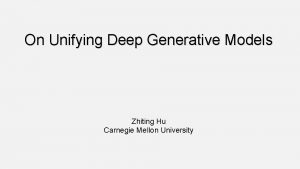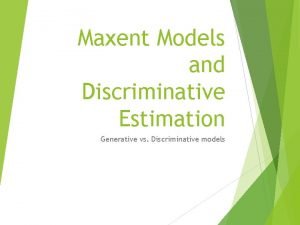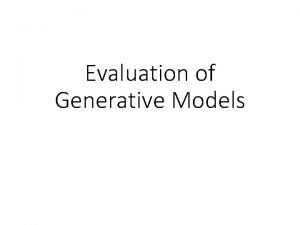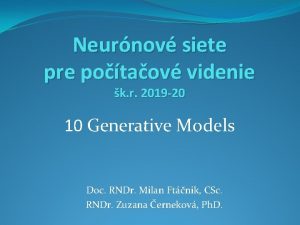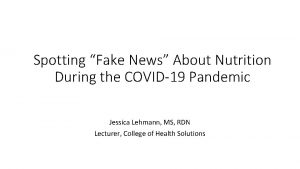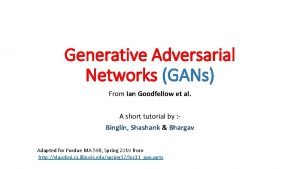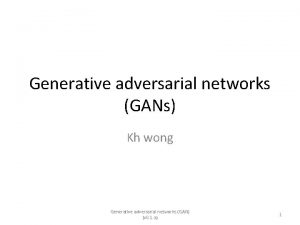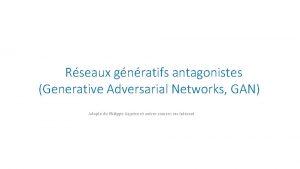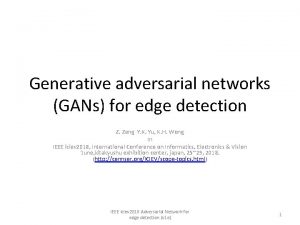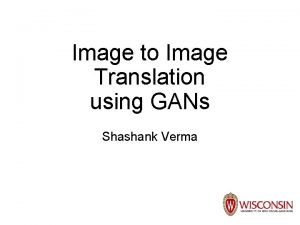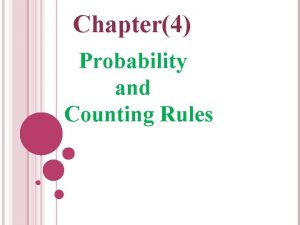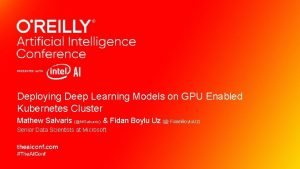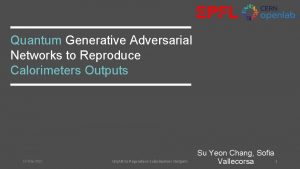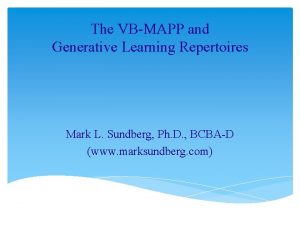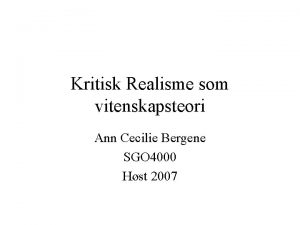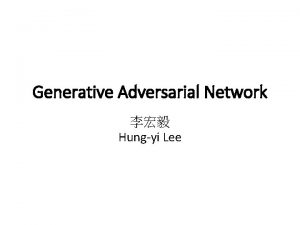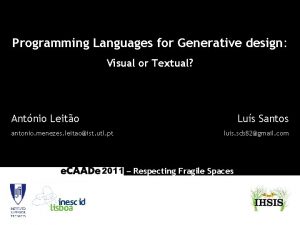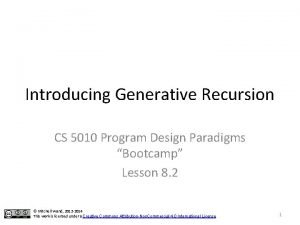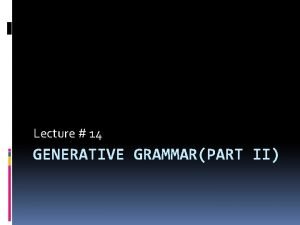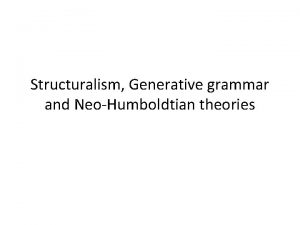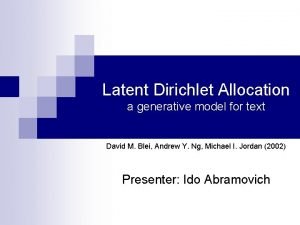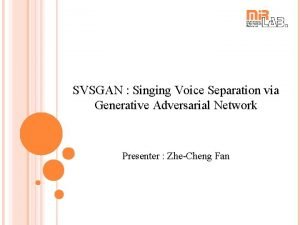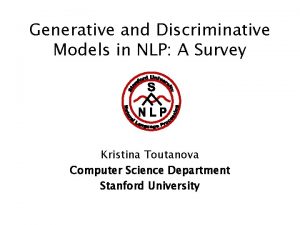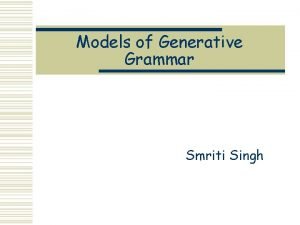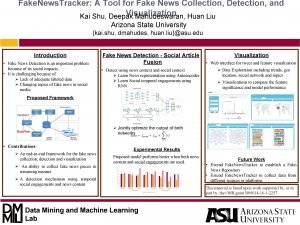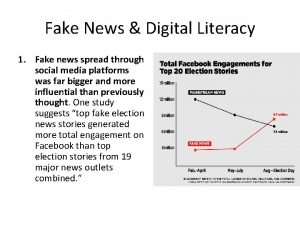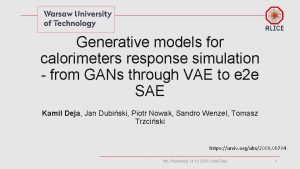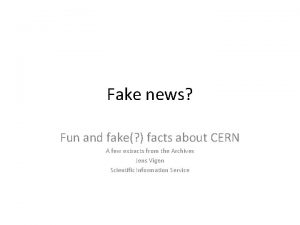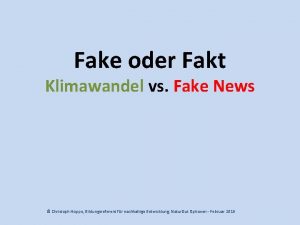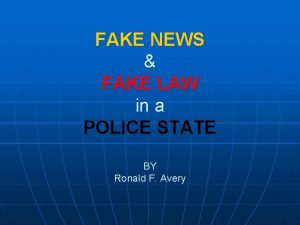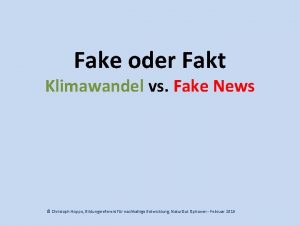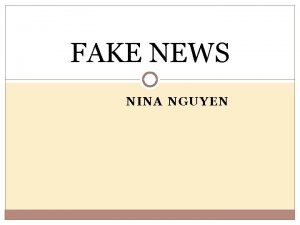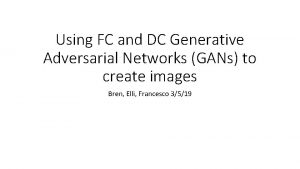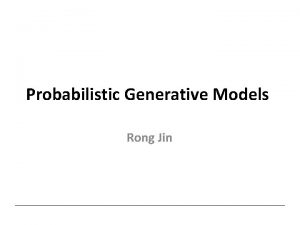Fake news no GANs Do Deep Generative Models
















































- Slides: 48

*Fake news, no GANs Do Deep Generative Models* Know What They Don't Know? Eric Nalisnick, Akihiro Matsukawa, Yee Whye Teh, Dilan Gorur, Balaji Lakshminarayanan (Deep. Mind) ICLR 2019 Presented by: Julius Hietala

TL; DR

*in some interesting cases TL; DR Normalizing flows, VAEs, Pixel. CNNs aren’t reliable enough to detect out of distribution data*

Outline • Paper introduction • Some notes • How normalizing flows work? • Paper experiments • Paper findings • Conclusions • Discussion

Paper introduction • Density estimation/determination is used in many applications (anomaly detection, transfer learning etc. )

Paper introduction • Density estimation/determination is used in many applications (anomaly detection, transfer learning etc. ) • These applications have spawned interest towards deep generative models

Paper introduction • Density estimation/determination is used in many applications (anomaly detection, transfer learning etc. ) • These applications have spawned interest towards deep generative models • Currently popular choices are VAEs, GANs, auto regressive models, and invertible latent variable models

Paper introduction • Density estimation/determination is used in many applications (anomaly detection, transfer learning etc. ) • These applications have spawned interest towards deep generative models • Currently popular choices are VAEs, GANs, auto regressive models, and invertible latent variable models • The latter two are interesting due to the fact that they allow for exact likelihood calculation

Paper introduction • Density estimation/determination is used in many applications (anomaly detection, transfer learning etc. ) • These applications have spawned interest towards deep generative models • Currently popular choices are VAEs, GANs, auto regressive models, and invertible latent variable models • The latter two are interesting due to the fact that they allow for exact likelihood calculation • Main question of the paper: can these models be used for anomaly detection?

Some notes • The authors report results for VAEs, Pixel. CNNs, and normalizing flows.

Some notes • The authors report results for VAEs, Pixel. CNNs, and normalizing flows. • Only normalizing flows are discussed and studied in depth

Some notes • The authors report results for VAEs, Pixel. CNNs, and normalizing flows. • Only normalizing flows are discussed and studied in depth • Is their analysis applicable to all the different types of models?

How normalizing flows work?

How normalizing flows work? • *Illustration stolen from here: https: //www. youtube. com/watch? v=P 4 Ta-TZPVi 0

How normalizing flows work? •

How normalizing flows work? •

How normalizing flows work? •

How normalizing flows work? •

How normalizing flows work? •

How normalizing flows work? •

How normalizing flows work? • Example from Real. NVP (https: //arxiv. org/pdf/1605. 08803. pdf): *s and t are NN()

How normalizing flows work? • Example from Real. NVP (https: //arxiv. org/pdf/1605. 08803. pdf):

How normalizing flows work? •

How normalizing flows work? •

How normalizing flows work? •

How normalizing flows work? •

How normalizing flows work? •

How normalizing flows work? •

Paper experiments • Train the model (Glow) on one data set (in distribution), afterwards determine likelihoods for the training data (in distribution) and another data set that was not used in training (out of distribution)

Paper experiments • Train the model (Glow) on one data set (in distribution), afterwards determine likelihoods for the training data (in distribution) and another data set that was not used in training (out of distribution) • Data set/distribution pairs: • • Fashion. MNIST vs. MNIST CIFAR-10 vs. SVHN Celeb. A vs. SVHN Image. Net vs. CIFAR-10/CIFAR-100/SVHN

Paper findings • Fashion. MNIST vs. MNIST

Paper findings • Fashion. MNIST vs. MNIST

Paper findings • CIFAR-10 vs. SVHN

Paper findings • CIFAR-10 vs. SVHN

Paper findings • Celeb. A vs. SVHN

Paper findings • Celeb. A vs. SVHN

Paper findings • Image. Net vs. CIFAR-10/CIFAR-100/SVHN

Paper findings • Image. Net vs. CIFAR-10/CIFAR-100/SVHN

Paper findings • Other model types

Paper findings • The observations presented were the main contributions of the paper, grain of salt needed with next points

Paper findings • The observations presented were the main contributions of the paper, grain of salt needed with next points • They try to explain the phenomenon, but raising many questions from the reviewers

Paper findings • The observations presented were the main contributions of the paper, grain of salt needed with next points • They try to explain the phenomenon, but raising many questions from the reviewers • Change of variable formula* term analysis:

Paper findings •

Paper findings •

Paper findings •

Paper findings • Then hypothesize that reducing the variance of the data artificially will increase the likelihood

Conclusions • Cause to pause when using generative models in anomaly detection • Second order analysis provided (only applicable to a certain type of flow + many assumptions) • The author’s urge further study on the subject

Discussion • How valid/applicable is their analysis? • How come samples do not look like the OOD images if they have higher likelihood?
 Normalizing flow
Normalizing flow Zhiting hu
Zhiting hu Generative vs discriminative
Generative vs discriminative A note on the evaluation of generative models
A note on the evaluation of generative models Taxonomy of generative models
Taxonomy of generative models What does sanctioned countries mean
What does sanctioned countries mean Fake news about nutrition
Fake news about nutrition Fake news
Fake news Fake news
Fake news Fake news
Fake news Craig finlay
Craig finlay Joan naturale
Joan naturale Reflekterende artikel eksempel
Reflekterende artikel eksempel Dr michael gans
Dr michael gans Goodfellow gan
Goodfellow gan M*ngulshagai gans*kh
M*ngulshagai gans*kh Instabilité
Instabilité M*ngulshagai gans*kh
M*ngulshagai gans*kh Brigitte gans
Brigitte gans Applications of gans
Applications of gans Gans loss function
Gans loss function Deep forest: towards an alternative to deep neural networks
Deep forest: towards an alternative to deep neural networks 深哉深哉耶穌的愛
深哉深哉耶穌的愛 Deep asleep deep asleep it lies
Deep asleep deep asleep it lies No news _____ good news.
No news _____ good news. What is hard news
What is hard news Probability and counting rules examples with solutions
Probability and counting rules examples with solutions Deploying deep learning models with docker and kubernetes
Deploying deep learning models with docker and kubernetes Semi modals
Semi modals Unsupervised image to image translation
Unsupervised image to image translation Quantum generative adversarial learning
Quantum generative adversarial learning Vb mapp definition
Vb mapp definition Ontologisk realisme
Ontologisk realisme Generative adversarial networks
Generative adversarial networks Generative design grasshopper
Generative design grasshopper Hudson safety culture
Hudson safety culture Bayes intranet
Bayes intranet Structural linguistic and behavioral psychology
Structural linguistic and behavioral psychology Generative recursion
Generative recursion Generative grammar examples
Generative grammar examples Generative meditation
Generative meditation Generative lymphoid organs
Generative lymphoid organs From structuralism to transformational generative grammar
From structuralism to transformational generative grammar Lda generative model
Lda generative model Generative adversarial network
Generative adversarial network Deep and surface structure examples
Deep and surface structure examples Nlp generative model
Nlp generative model Generative thinking boards
Generative thinking boards Generative grammar
Generative grammar

